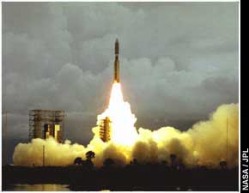Viking 1 Info
The organization that was the main part of this mission was JPL and Nasa. The Viking space program wanted to be the first mission to land a spacecraft successfully on the surface of another planet, and return with imaging and non-imaging data. This happened over a long period of time. First, let's talk about the structure of the spacecraft. The ship was combined with jet fuel tanks on the bottom, and on the top was an Orbiter and Lander. Now, it's time for lift off. The launch date was August 20, 1975. When the spacecraft has lifted into space, it sets course for its destination, Mars. The ship got to Mars on June 19, 1976. Once it has gone into Mars' orbit, the Orbiter stays on the orbiting path, and the Lander detaches from the spacecraft and heads for Mars' surface. The Lander makes it to the surface on July 20, 1976 (one day later). On Mars, there are lots of slopes, mountains, and valleys. That's where the Lander landed. Actually, it landed on the Western slope of Chryse Planitia, (The Plains of Gold). While the Lander was on Mars, it not only took photos, and collected data, but conducted three biology experiments. They were designed to look for possible signs of life. The mission was to continue for 90 days after landing. After it was all done with Mars, it traveled back to Earth on November 11, 1982.

